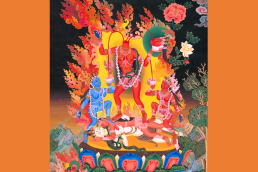On 24 February 2022, Cosmopolitan magazine taught its readers “Everything You Need to Know if You’re Curious About Tantric Sex”. Attentive Cosmo readers have probably noted that in in every sex and relationship article, Cosmo’s editors inevitably imply that orgasms are de rigueur – with or without a partner. This is so, regardless of the sexual practice under discussion.
This unwritten rule no doubt made the task of this article’s author, Naydeline Mejia, quite challenging when she tackled sexual tantra, with its strictures concerning orgasm. Mejia briefly alludes to the venerable tantra and sexual tantra traditions. (These evolved within Buddhism during the first millennium CE.) She then narrows her focus to the flavours of tantra around today, so-called neotantra.
Neotantra typically confines itself to appealing, conventional goals, such as the promise of connection, intimacy, and pleasure with a partner. In fact, much of the article’s sensual content seems calculated to intensify sexual longings. Might Cosmo’s editors hope that readers will attempt to fulfill those yearnings by acquiring advertisers’ wares?
Certainly this strategy makes good sense from a physiological point of view if the magazine is trying to sell things. (It is.) Sexual cravings and orgasm create a subtle, subconscious sense of dissatisfaction (which is especially potent after orgasm and lingers). When feeling dissatisfied, we routinely try to ease our distress with material-plane “solutions” (a new hair-care product, a sex toy, something sugary, and so on). Instead of learning to increase subconscious feelings of wholeness and wellbeing by managing their sexual energy carefully, alone or with a partner, Cosmo’s readers may find themselves reaching for things outside themselves to try to feel better. Buyer beware!
Back to the article
Neotantra seldom underscores the warnings against sexual orgasm in traditional tantric texts. And Mejia’s piece is garnished with reassuring comments like “The goal … is not necessarily to reach orgasm. (But if you do, that’s okay.)” And “Yes, it’s possible to experience orgasm during tantric sex”.
Even when the author slips in the awkward truth, “Remember, the goal of tantric sex isn’t to reach orgasm”, it’s quickly followed by a neotantrist’s comment that, “Sometimes I’m having amazing orgasms, other times I’m moving through a block”. Cosmo editors can’t have their readers dwelling on why someone might sidestep sexual orgasm!
Incidentally, in the article, the underlined words “reach orgasm” link to an article in which over 50 women describe what an orgasm feels like. That should get readers hot and bothered enough to require retail therapy.
Interested in what the ancient tantric masters taught?
If you’d like to move beyond Cosmo’s predictable fare, consider the following excerpts. They come from the archives of Buddhist teacher Alexander Berzin, who publishes ancient texts in modern language. Berzin makes this knowledge available for serious Buddhists seeking to attain liberation (enlightenment). The excerpts below come from the Kalachakra Buddhist tradition.
The first excerpts come from the Secondary Tantric Vows.
- By relying on the bliss and joy that come from union with one, without orgasmic release, a male enhances his blissful discriminating awareness of voidness. A female can accomplish the same while in union with a man, also without orgasmic release, by relying on the fact of her being a woman.
- It is important that our sexual partner share our attitude toward sex. An unqualified partner is someone who does not view sex from a tantric perspective.
- [The vows add that it totally defeats tantric practice to regard] ordinary sex and the bliss of orgasmic release as a path to liberation or enlightenment. … If our partner is merely obsessed with greed and attachment for carnal pleasure, or views achieving a healthy orgasm as the cure for all psychological disorder, we easily fall prey to such emotions or ideas, and lose our perspective.
There’s more
The next excerpts derive from The Fourteen Kalachakra Tantra Root Downfalls. A ‘root downfall’ makes spiritual practice impossible and thus severs the root of any previous spiritual accomplishment. A ‘branch downfall’, by contrast, is a less severe fault, which merely delays such accomplishment. For those on the spiritual path, sexual orgasm is a “root downfall”.
- Any experience of orgasmic release, regardless of how we view it … counters the purpose of trying to achieve enlightenment as quickly as possible.
- Whether male or female, whenever we experience the release of energy that accompanies sexual orgasm – regardless of the emission of gross fluids – we lose subtle creative drops, called “bodhichitta” or “jasmine flower drops.” These drops form the basis for achieving unchanging blissful awareness. Since such release discards the most efficient means for achieving enlightenment, it is called “giving up bodhichitta.”
- Never … regard the bliss of orgasmic release from ordinary sex as a spiritual experience, as a way to solve all problems, or as a path to enlightenment.
We can thank Mejia for her valiant effort to call sexual tantra to readers’ attention. It’s up to the rest of us to dig deeper if we would understand tantra’s more profound implications for those seeking to tap its spiritual potential. If you’re curious about the many cultures that emphasised the gifts of non-orgasm driven sexual union, visit Traditions.



